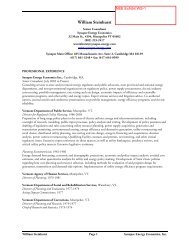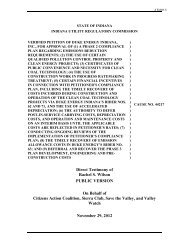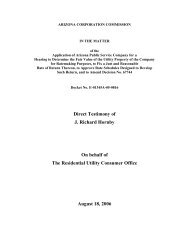Best Practices in Energy Efficiency Program Screening - Synapse ...
Best Practices in Energy Efficiency Program Screening - Synapse ...
Best Practices in Energy Efficiency Program Screening - Synapse ...
You also want an ePaper? Increase the reach of your titles
YUMPU automatically turns print PDFs into web optimized ePapers that Google loves.
<strong>Efficiency</strong> program screen<strong>in</strong>g should account for avoided transmission and distribution<br />
costs, dist<strong>in</strong>guish<strong>in</strong>g between those costs that can be deferred or avoided through<br />
energy efficiency and those that cannot. Avoided transmission costs should be based on<br />
forecasts of future transmission activity, as opposed to historical activity, especially <strong>in</strong><br />
regions of the country that anticipate significant <strong>in</strong>creases <strong>in</strong> transmission <strong>in</strong>vestments.<br />
The avoided costs of compliance with environmental regulations should be explicitly<br />
accounted for <strong>in</strong> the Societal Cost test, the TRC test and the PAC test. This should<br />
<strong>in</strong>clude costs associated with compliance with current and anticipated environmental<br />
regulations from the US Environmental Protection Agency. This should also <strong>in</strong>clude<br />
costs associated with compliance with current and anticipated federal, regional and state<br />
<strong>in</strong>itiatives to curtail the emissions of greenhouse gases.<br />
<strong>Efficiency</strong> program screen<strong>in</strong>g should also account for the price suppression effects, <strong>in</strong><br />
those regions of the country that participate <strong>in</strong> competitive wholesale electric markets.<br />
Even a small reduction <strong>in</strong> a market clear<strong>in</strong>g price can result <strong>in</strong> significant cost reductions<br />
across the entire market.<br />
<strong>Efficiency</strong> program screen<strong>in</strong>g should also properly account for electricity transmission<br />
and distribution losses. The estimate of losses should be based on marg<strong>in</strong>al losses.<br />
Captur<strong>in</strong>g All the Impacts of <strong>Energy</strong> <strong>Efficiency</strong><br />
Each state that uses the TRC test or the Societal test should (a) identify all of the OPIs<br />
that are relevant for the energy efficiency programs offered <strong>in</strong> the state; (b) develop<br />
quantitative estimates for all OPIs that can be readily quantified; (c) develop some<br />
methodology for address<strong>in</strong>g those OPIs that are not quantified; and (d) pay particular<br />
attention to the OPIs that are unique to low-<strong>in</strong>come customers. States should hire<br />
<strong>in</strong>dependent contractors to develop the best state-specific OPI estimates possible.<br />
<strong>Efficiency</strong> screen<strong>in</strong>g practices should properly account for free-riders, spillover effects<br />
and market transformation. These effects should be estimated and accounted for <strong>in</strong> a<br />
manner that is timely, consistent and comprehensive. <strong>Program</strong>s that are expected to<br />
have significant market transformation impacts should be provided with greater flexibility<br />
<strong>in</strong> the screen<strong>in</strong>g process.<br />
<strong>Efficiency</strong> screen<strong>in</strong>g practices should properly account for the risk benefits of energy<br />
efficiency, either through system model<strong>in</strong>g or through risk adjustments to the energy<br />
efficiency benefits.<br />
<strong>Efficiency</strong> Screen<strong>in</strong>g Methodological Issues<br />
The discount rates that are applied to the TRC test and the PAC test should reflect the<br />
fact that energy efficiency <strong>in</strong>vestments pose lower risks to the utilities relative to supplyside<br />
<strong>in</strong>vestments. We recommend the use of a generic market <strong>in</strong>dicator of a low-risk<br />
<strong>in</strong>vestment such as the <strong>in</strong>terest rate on long-term US Treasury Bills.<br />
<strong>Energy</strong> efficiency screen<strong>in</strong>g practices should account for the sav<strong>in</strong>gs available over the<br />
full life of the energy efficiency measure.<br />
<strong>Energy</strong> efficiency programs should not be screened at the measure level. We<br />
recommend that energy efficiency programs be screened at the program level us<strong>in</strong>g the<br />
<strong>Best</strong> <strong>Practices</strong> <strong>in</strong> <strong>Energy</strong> <strong>Efficiency</strong> <strong>Program</strong> Screen<strong>in</strong>g | www.nhpci.org | 59







